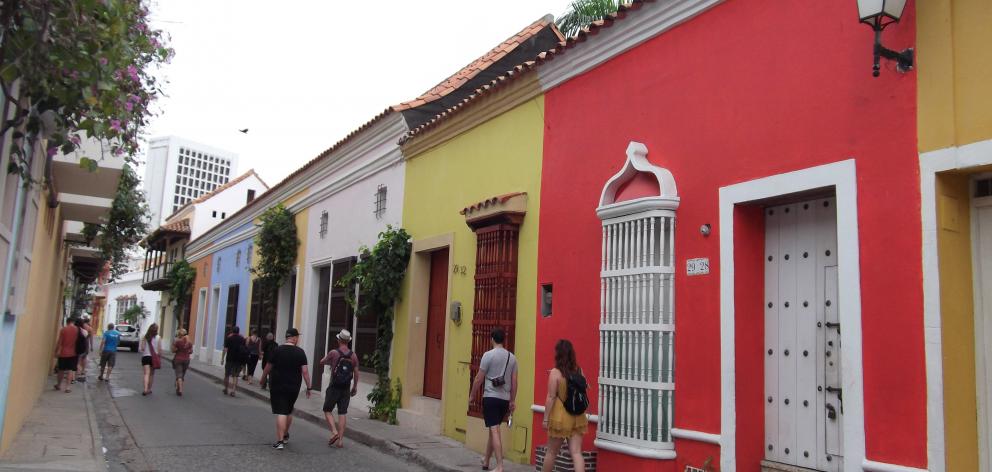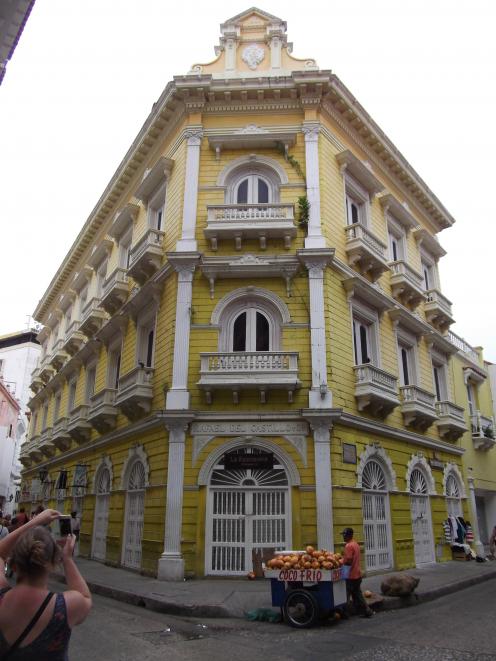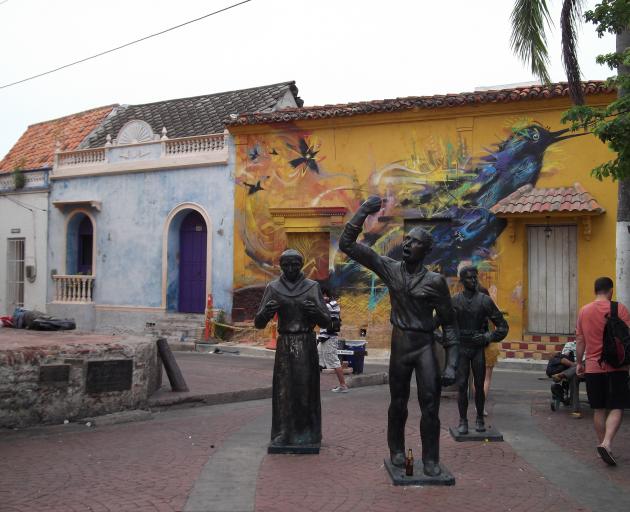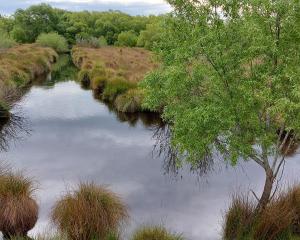
A salmon pink home adjoins a mustard dwelling, next to a white residence joined to a pale blue one. Opposite, a two-storey building's narrow balcony hangs above the footpath with bougainvillea cascading, cerise flowers dotting it. Among pristine homes are ones with paint flaking or faded, while crumbling plaster reveals stone walls on others. Getsemani's shabbiness adds to the character of Cartagena, Colombia.


In a narrow thoroughfare, the sun yet to brighten it, palms in terracotta pots take up the pavement. We walk on cracked, concrete roads past homes of rich hues. Painted wood grilles cover windows, and lanterns hang above doorways. A teenager bikes past in the otherwise deserted street. I could live here. It's far from my imagined Colombia - scared-to-walk-down streets and populated by drug lords. This is quaint ... but the heat ... and house prices can apparently hit $US1million ($NZ1.5million).
Parque Centenario's greenery is a contrast from Getsemani's dusty, concrete roads. A sloth was seen here yesterday. Strolling through, I peer up into the canopy but am disappointed. I don't even spot a bird.
The 13km stone wall built in the 17th and 18th centuries to protect Cartagena from pirate attacks looms ahead. To the left is a peek of the Carribbean which bore those plunderers to this long ago port of riches - gold, silver and emeralds were shipped from here to Spain. A busy road separates park from wall. After Getsemani's centuries-old streets it's a reminder of the modern world as are distant high-rise buildings. We walk the pedestrian crossing leading to Torre del Reloj, the clock gate, and enter the middle archway.


Which explains why, when I disembarked the plane, saw the people, palm trees and beach, I felt I'd arrived on a Caribbean island. The man who approaches selling Panama hats could be a descendant of those Africans.
Pedro Claver, a Spanish monk who dedicated his life to caring for the thousands of slaves lived around the corner in the convent now named after him. Bell towers, like sentries, flank the stone Iglesia de San Pedro Claver in the coral pink-bricked plaza which resembles an outdoor art museum. Metal sculptures portray traditional life in Cartagena - among them four figures play a game at a table and a woman works at a sewing machine. Another pushes a cart and we see the real thing on street sides. To quench their thirst, several of my group buy coconuts from a man pushing a loaded wooden barrow. I hand over my pesos for diced watermelon to a women at a cart laden with tropical fruit.
Walking down a narrow, leafy calle is a chance to be out of the sun, although it makes little difference in the sweat trickling down my front. I spot a mustard and russet bell tower with trimmings of white moulds poking above rooftops. It's ornateness is striking among the simplicity of surrounding buildings. It is a later addition to the mustard-painted 16th-century cathedral, so unassuming I don't give it a second glance, which was partially destroyed before completion by the cannons of a man who in this part of the world was a pirate, Sir Francis Drake. Models of galleons like those sailed by Spanish and pirates are for sale in cobbled squares. Laid-back sellers also display on blankets brightly woven bags, striped espadrilles, hand-crafted jewellery and maracas.

I follow Jose at a lazy pace, my shirt damp, limbs heavy, water bottle near empty. Narrow and wide thoroughfares that are becoming more populated are a maze. The smell of arepas frying on a pushcart makes my mouth water as I wait in shade for members of my group who got left behind photographing picturesque scenes.
Without Jose I'd be lost. But now acquainted with Cartagena, I'd happily wander alone being delighted at the turn of every corner in this easygoing old town rich in history, rich in colour.












